Message 529, Jan 19, 2004
Hi all, Just received a letter from Bloodhound with copies of all the documentation that
came with his DH-101 helmet (thanks a million Bloodhound). It takes a bit of digestion but
meanwhile you can enjoy two of the drawings from the documentation.
One shows that the helmet was indeed meant for use with an oxygen mask which solves the
conceptual communications question. It leaves the enigma of why none of the helmets seen
so far have had oxygen mask receivers installed. (Drawing #1)
The other shows how to connect the helmet and trigger unit to each other and to the
aircraft. This drawing reveals an error in the A-7A NATOPS flight manual. The legend to
the NATOPS drawing (see message 394 on the Best of Flightgear website DH-101 page) says
that #5 is the connection to the nuclear flash detector (on LH console) but as can be seen
in the present drawing (use link below) it is in fact just the communications cable. The
NATOPS drawing is missing the third cable from the trigger unit to the LH aircraft side
control console. (Drawing #2)
Cheers, Bluelight
Message 468, Jan 15, 2004
Spurred by this discussion I have ordered the A-7A flight manual on CD from
http://www.eFlightManuals.com. I have heard others (Shark, was it?) have had less that
ideal transactions with that company but now we will see. I will let you know when (if?) I
get it.
Cheers, Bluelight
Message 467, Jan 15, 2004
Hi Bloodhound, This still leaves the communication question open. As DocBoink has not
heard about any early 1960's NBC-hood (with associated oxygen and comms functions) I think
that we can drop that theory. An individually suspended oxygen mask like the quick-don
masks used in transport aircraft might be a possibility but why chose such a system
instead of oxygen mask receivers on the helmet itself?
Maybe you are right, Craig, that the helmet did not reach an operational state, and the
helmets we have seen so far in the group have not been flown. I had better stop here lest
I theorise ahead of the facts. Looking forward to hearing from your Vought contact.
Cheers, Bluelight
Message 463, Jan 14, 2004
Bluelight & other DH-101 fans: I should hear from my contact at Vought by tomorrow,
which hopefully will cast some light on this issue. I've spoken to two friends and fellow
advanced collectors regarding the DH-101. Neither of them are involved with the flightgear
forum or our group, and so not a duplicate source of information. One of whom has had 3
pass through his hands over the years, and the other has seen a couple for sale at various
places across the U.S. Surprisingly, or perhaps not, neither had ever seen one with oxygen
mask recievers or a boom mike. ...for what it's worth.
Best, Bloodhound
Message 455, Jan 13, 2004
Sorry, but to the best of my knowledge, the US Navy did not use any sort of bio-chem
protective ensemble until the introduction of the UK's AR-5 assembly for AV-8 crews in the
late 70s. Absolutely nothing in the way of bio-chem hoods, etc., were in use in the 60s
among Navy crews--only nuclear protective assemblies. However, a possibility exists that
some sort of white anti-flash hood may have been in use with the all-white
helmet/mask/suit/MA-2 outfits. I have no information on such a hood, if it in fact ever
existed.
Cheers, DocBoink
Message 454, Jan 13, 2004
Wished I had the entire manual but those pages were all that was provided to me. I have
had them for over 10 years.
I am not sure the DH-101 ever made it to production but the Navy did have another system
A/PPS-35 (don't have the number in front of me) Photochromic Goggle and that system at
least made it to specifications. It looks like a primitive version of the USAF PLTZ, was
designed for the Navy by EE&G. I didn't mention it before as the conversation was on
the DH-101. I have some test photos of the system somewhere and I wil post when I get
home.
cheers, Figmo
Message 450, Jan 13, 2004
Hi Bloodhound, This is an interesting difference from what I am familiar with from USAF
and RDAF procedures. Test equipment and equipment on RDT&E would be covered by a
temporary supplement to the Dash 1 and only when declared operational it would be part of
the main body of the manual. Unfortunately I do not own the A-7A NATOPS myself. Figmo
provided me with a few scans of the relevant pages. Let's hear what your contacts have to
divulge. Your Vought program manager sounds promising.
Cheers, Bluelight
Message 448, Jan 13, 2004
Hi Bloodhound et al, So both gold-coated and explosive coating with graphite? This
suggests that the "ordinary" gold-plated helmet visors and the G-635 goggles
only have limited protection against a nuclear flash. It also suggests why the G-635
goggle kit includes the monocular eye shield. It would be great if you could dig out a
picture of your exposed lens for comparison.
Cheers, Bluelight
Message 447, Jan 13, 2004
Hi Bloodhound, That could very well be, of course. [see message 439]
Cheers, Bluelight
Message 442, Jan 13, 2004
Bluelight (and everyone else following the saga): First, let me say Bravo! for your
industriousness in starting this thread, and taking the initiative in this research
project! This is great stuff, and the reason our splinter group was begun.
I agree with you, in part. The evidence at hand (or at least some of it) does seem to
suggest that the helmet was operational. However, we first must define operational. In
Navy parlance, it's not operational until it is introduced into "The Fleet."
Merely appearing in a flight manual does not necessarily make it operational. Many a
flight manual has been augmented with test program components, where those components
never got past RDT&E.
There are numerous programs being tested this very moment at U.S. Navy installations like
Patuxent (Pax) River, Point Mugu, and China Lake, some of which will and some of which
won't make it past the RDT&E stages. The program managers have information inserted
into the NATOPS manuals to enable the flight crews to properly evaluate the system or
equipment in a "fleet" setting. They don't want the fleet pilots to get the
information in a different manner, so they augment a few NATOPS manuals with the program
specifics. I have a few manuals with such augmentations, and that's as far as they got.
You may have a very unique and collectible A-7A NATOPS manual!
Since we know that in the US Navy around that era, the A-5/RA-5C, A-4, and A-7 were Nuke
capable, I reached out to a contact within the A-4 community for input. The father of a
friend of mine flew A-4's in the U.S. Navy from 1963 to 1967, then F-8's through the
1970's. I sent him some photos of the DH-101, and his quote was: "I've never seen
that helmet before." His squadron (which was deployed to Vietnam) was issued 2 sets
of what they affectionately called the "Sir Gallahad Suit." He was one of the
two pilots issued the set. We're more familiar with it as the set of all white anti-Nuke
flight gear, pieces of which appear from time-to-time on ebay. He said that along with the
various all white flight gear components, the helmet used with the "Gallahad"
set was a standard APH-6 with gold coated visor. Their instructions in the event of
potential nuke action were to: at their discretion, keep one eye closed!
I still have some feelers out which should come back within a day or two. One of the
contacts was a program manager at Vought, who was heavily involved with the A-7. He will
know one way or the other! I'll keep you posted. I also have a Vigilante contact, but more
remote.
Best, Bloodhound
Message 440, Jan 12, 2004
Bluelight: That visor is my good one, and is gold coated. The triggered visor insert I had
sold on ebay some time ago. I think I may still have a picture of it, so I'll have a look.
Best, Bloodhound
Message 439, Jan 12, 2004
Bluelight: Yep, it's missing, but as mentioned before, this is an in-the-box with
instruction manuals and test sheet specimen. Perhaps the sensor as well as trigger unit
were separately acquired? I'm working on a lead to fill some of the holes in the DH-101
story, and should be able to post my findings later today.
Best, Bloodhound
Message 438, Jan 12, 2004
Hi Bloodhound et al, Another possibility is that some kind of NBC-hood was worn under the
DH-101 or that a mask with neck strap was used.
Doc, are you aware of any NBC protection worn by USN pilots in the 1960s?
Cheers, Bluelight
Message 437, Jan 12, 2004
BTW, Bloodhound, it looks as if your helmet is missing the nuclear flash sensor?
Cheers, Bluelight
Message 436, Jan 12, 2004
Hi Bloodhound, Great pictures this time, thanks! Is that the triggered visor lens that you
mentioned in message #253? You said that it looked like an Etch-a-Sketch screen and that
description fits alright. Could be the graphite that does the trick.
Looking at the labels at MichaelFox' helmet the Gentex model number designation seems to
be DH-101A for a large helmet while Omnitech's part no. is 144-A. I do not know which is
more correct to quote for the entire assembly.
Cheers, Bluelight
Message 430, Jan 12, 2004
Hi Bloodhound, I do not know what to think because the A-7A flight manual gives a
description of the DH-101 helmet, describes the operation of the flash curtains triggered
by the helmet flash sensor, and illustrates the two ELF lens containers attached to the
ejection seat. I would take that as a strong indication that the system was operational.
Otherwise it would be illogical to enter it into the flight manual. The illustration in
the flight manual shows the DH-101 without oxygen mask receivers or boom mike, so either
the drawing is inaccurate or the helmet was used without any comms (for transmission that
is). If the latter was the case then the pilot should be able to carry both his normal
helmet and the DH-101, the normal helmet for take-off, transit flight, and (hopefully)
return flight and landing, while the DH-101 woudl only be used for the penetration phase
and weapons delivery which might be done under radio silence. Not a very likely scenario I
admit, two helmets in a cramped cockpit, and radio silence can be achieved just by
avoiding to transmit. No need to go to the extreme of not providing the pilot with a
microphone.
Cheers, Bewildered-light
Message 421, Jan 12, 2004
Bluelight: I too have noticed the conspicuous lack of mask receivers or boom microphone.
Until your recent uncovering of all the examples tucked away within the collections of
members of the group, I assumed that mine was an unusual unissued example sans recievers!
Could it be that all the examples we've seen so far were non-operational examples? I
believe you're on to something by differentiating between the two contract numbers as
training and operational units, but perhaps even the operational procurement units we've
seen were unused? We knew, or at least strongly suspected that this was an extremely
limited program, which may have never seen deployment in the fleet or land based units,
despite the apparently high serial numbers, possibly indicating almost 800 units!?!?!?! I
think we need a larger sample of units to examine before drawing any conclusions in that
regard. I have a good friend who's father flew A-4's in the early sixties. I'll pass the
photos along and see if they look familiar to him at all. Maybe he can tell us something
about the use of the DH-101. The search for information continues!
Best, Bloodhound
Message 420, Jan 12, 2004
Bluelight & Everyone Else: Here are some better(?) shots of my DH-101A. My poor little
digital camera won't allow me to command the flash... it's automatic when it feels it
needs it. If these don't suit your purposes, I will retake them. As a point of correction,
I misstated the two model number designations in a previous e-mail as DH-101A & B. The
actual model designations from the paperwork I have is 144A (large) & 144B (medium).
The following info is on the back label of my specimen:
Part No. 144-A
Size: Lge
Serial No. 717
Best, Bloodhound





DH-101A helmet with gold-coated operational visor. The nuclear flash sensor is not installed in its recess above the visor frame.© Bloodhound
Click on the pictures to see high-resolution pictures
Message 396, Jan 11, 2004
Hi all, One thing in still a mystery to me; Why does none of the helmets we have seen so
far have oxygen mask receivers fitted? Or a boom microphone? How does the pilot
communicate with this thing on? Bloodhound's papers include Instructions for fitting
oxygen mask retention and release assemblies, chin strap assembly, and light shielding
pads to the ELF-F Flashblindness Protective Helmet System so that may answer part of it.
Cheers, Bluelight
Message 394, Jan 10, 2004
Hi Blaster and group,
The additional information I mentioned just a mail ago was a scan of a drawing from the
NAVAIR 01-45AAA-1 flight manual A-7A dated April 1967. It shows the DH-101 helmet and how
it is connected. The legend to the drawing is as follows:
1. Nuclear Flash Sensor
2. Visor Frame
3. Trigger Unit
4. Approved Protective Helmet
5. To Nuclear Flash Detector (LH Console)
6. ELF Lens
This is the first illustration I have come across that shows the trigger unit, which is
kept in the pilot's pocket. The connection of the two cords to the trigger unit is easily
recognisable when you compare with two plugs shown in Milehigh's pictures.
Thanks to Figmo for providing the scan. The next step in the DH-101 sleuthing process is
studying the copies that Bloodhound has kindly promised to send to me of the papers that
came with his helmet. When that is done I would guess that the technical description is
more or less complete.
Cheers, Bluelight
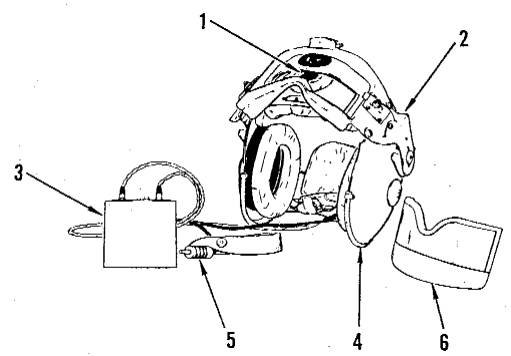
Message 393, Jan 10, 2004
Hi Blaster et al,
Thanks for the pictures. Always nice to have your theories confirmed. I would venture the
guess that of the two contracts we know of, N156-46680 was for the procurement of training
helmets (the ones with black cord and tube), and N156-42471 for the procurement of
operational helmets (the ones with two white braided cords).
It seems that three types of lenses exist. One is the operational lens with an explosive
charge (it looks as if Bloodhound has one that has been fired), one is the air
pressure-operated training lens (Blaster's lens), and one is an inert lens modified from a
live lens but without charges (MichaelFox' lens has teh contact points from an operational
lens but a hole has been drilled to allow fitting to a training helmet with air tube). The
inert lens may have been used purely for training the correct handling and changing of
lenses or for display purposes.
Additional info on the topic just hit my inbox on discrete so I will keep you posted
before long.
Cheers, Bluelight
Message 388, Jan 10, 2004
OK Bluelight and gang,
I finally dug deep enough to get to the DH-101A, needless to say it was where anything you
want generally is, underneath everything in the recesses of some closet! Anyway, after a
day of searching, success at last. The contract number on the helmet is N156-46680. The
part number is 144A. The serial number is 815.
As you can see by the attached photo's, the lens is a training lens and it operates
exactly as Bluelight suggested, by air pressure. The curtain on the inside of the lens is
sectioned and attached to a pin assembly operated by air pressure. You can clearly see how
the curtain is attached in the photo. There is a second cord that is a power cord, again,
clearly visible in one of the photo's. I'm guessing that since this helmet has the sensor
on the top of the helmet, that it was an operational unit, possibly modified for training
purposes, but that is just a guess.
Keep me informed on the rest of your information gathering Sleuthlight!
Cheers, Blaster

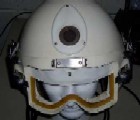
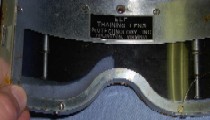
Left and middle: DH-101A training helmet. Right:
ELF training lens. The shutter
curtain has two parts, right and left, each split horizontally into three panels fixed
to a metal extension cylinder operated by air pressure. © Blaster
Message 373, Jan 8, 2004
Hi Bloodhound, Thanks for the pictures. They are a bit blurry so if you have the time to
redo them it would be great. Anyway, the visor insert is different from those I have seen
before so it would be very useful if you could include a couple of pictures of the helmet
without the visor insert and also of the rear of the insert itself. I am curious to see
the contact points.
I will send you my mail address on discrete frequency.
Cheers, Bluelight
Message 371, Jan 7, 2004
Bluelight: With the prospects for my scanner being operational bleak, how about I
photocopy the documents and send them to you? Give me your address, and I'll send them
off. Here's some pics of my DH-101. I had forgotten until I just dug it out that the cords
had been cut. Let me know if you'd like some better shots (I took these really quickly)!
Best, Bloodhound
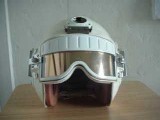
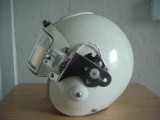
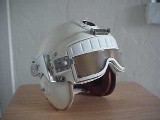
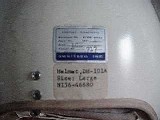
DH-101A with operational lens (gold-coated) © Bloodhound
Message 368, Jan 7, 2004
Hi Blaster, Biotechnology Inc.? That is the third company involved in the DH-101 project.
The other two mentioned so far are Omnitech and Bernite Powder. According to Bugs' sources
work on the helmet, and the development of lens transparencies having acceptable optics
and impact integrity was carried out at Omnitech. All work on explosives, and assembly of
the "live" lenses was carried out by Bernite Powder Company, Saugus, California.
Cheers, Bluelight
Message 363, Jan 7, 2004
Hey Bluelight, I will dig my DH-101A out of the closet tomorrow and give you the
information off of it. If I remember correctly my helmet has an ELF Training Lens made by
Biotechnology, Inc. I will give you more information tomorrow evening. So far, it sounds
like you are digging up some great information. Good job!!!
Cheers, Blaster
Message 357, Jan 6, 2004
Hi all, Thanks to Milehigh new information has surfaced on the DH-101 helmet from Jerry
'Bugs' Brulle, a former member of the old flightgear group. The former owner of Bugs'
DH-101A wrote to Omnitech in 1980 to get more information on the helmet and he received a
very informative answer from the retired general manager of Omnitech, Mr. Albert J.
Laliberte (at the time of writing Omnitech had been taken over by Gentex).
It turns out that the lens operates by getting a black, inky material sprayed on the inner
surfaces of the two visor lenses. The ink is sprayed by an explosive cord that lies at the
top of the visor between the two lenses when receiving a trigger pulse initiated from the
sensor at the top of the helmet through an electronics box carried in the pilot's pocket.
Pilots had to carry extra lenses to replace the old one after experiencing a "black
out". Milehigh included a number of pictures of his own DH-101 (see below)
It differs from the others by having white electrical cords instead of the black ones seen
on Blaster's and MichaelFox' helmets. I see two possibilities here. Either two different
operational visor systems were developed or one is the Inert and the other the
operational. Based on the very slim evidence seen so far I would hazard the guess that the
latter is the case. Before getting further into the world of guessing I would like to wait
for some further information from Bloodhound and Blaster, if possible.
Blaster, on your helmet it looks as if the upper half of the visor is dark and that the
lower edge of the dark area is curved like the bottom of the visor. Would it by any chance
be a curtain that could be operated by air pressure through the black tube? Could you also
provide the Contract No. of your helmet, please?
Cheers, Sleuthlight
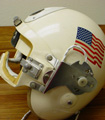
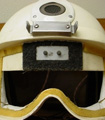
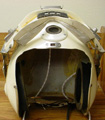
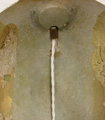
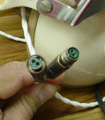
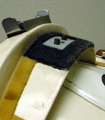
Far left and middle left: Side and
frontal view of Milehigh's DH-101A. The lens itself is missing
but the two contact points for firing the explosive charge are visible in the right
picture. Near left: Frontal view of
Milehigh's helmet with open visor. Note the two white braided
cords leading from the flash sensor (the cord in the middle) and leading to the visor (the
cord behind the earpad). Near right: Inside of helmet without styroliner. Shows the rear of the flash
sensor mounting recess and the electrical cord. Middle right: The plugs on the two white
braided electrical cords. Far right: A sideview of the two contact points for firing the explosive
charge in the visor lens.
All pictures © Milehigh
Message 256, Dec 30, 2003
Hi Bloodhound, This is good! An unissued DH-101; I am still amazed to hear the kind of
gems that are hidden in collections within the group. Photos would be very welcome,
indeed, and equally so would any scans of the documentation. References b) and e) would be
top of my list but c), d) and f) would be nice prizes, too. (Scanner still not working? If
not, consider this a gentle nudge).
Cheers, Bluelight
Message 254, Dec 29, 2003
Hi Bluelight, Yes, the Flightgear CD picture and these pictures are of the same helmet.
Best regards, MichaelFox
Message 253, Dec 29, 2003
Bluelight & Everyone Following the DH-101 Saga: I too have a DH-101, in unissued
condition, with some paperwork which you may find interesting. I will take some photos and
send them tomorrow afternoon for anyone interested. My 101 came with the following
paperwork:
a). A pair of original APH-6 cardboard sizing calipers
b). Instructions for assembly and use of components with the ELF Flashblindness Protective
System
c). Instructions for connecting battery in trigger unit
d). Instructions for fitting oxygen mask retention and release assemblies, chin strap
assembly, and light shielding pads to the ELF-F Flashblindness Protective Helmet System
e). Operational Test Information for ELF System
f). a Gentex "Instructions for removal and replacement of phone housing w/ ear
cushion assy. Helmet --- Type APH-6A DH-101A
Many of the documents feature diagrams, and one particularly illustrative shows the
connection procedure for the battery in the trigger unit, as well as the helmet to the
trigger and aircraft connections. Some information gleaned from the documents which may or
may not have been mentioned to date includes
-The manufacturer, Omnitech, Inc. was located in Dudley, Massachusetts
-There were 2 models: DH-101A (large) and DH-101B (medium)
-The trigger device housed the built-in rechargeable battery, and the firing circuitry,
and was to be carried in "breast pocket."
-The contract number on the documents (haven't checked my helmet yet) is: N156-42471,
which indicates there were at least two contracts for procurement of this system as it
differs from that provided by MichaelFox
Finally, the Operational Test Information sheet includes a photo of the firing pulse, as
well as the following information:
- Battery Circuit Drain................ 8.8 ma
- Pulse Output into Dummy ........ 314,500 ergs
- Vertical Sensitivity.................. 20 volts/cm
- Horizontal Trace Speed............ 1 microsec/cm
- Helmet Serial number............... 477
- Date Tested.......................... 9/03/1965
I used to have an exposed/triggered ELF lens assembly, and it had the look of an
etch-a-sketch screen (for those familiar with that toy). I'll dig out the helmet itself
and take a few shots tomorrow.
Cheers, Bloodhound
Message 251, Dec 29, 2003
Hi MichaelFox, Thanks very much for the additional pictures. The picture that you provided
for the Flightgear CD and that I have used for the draft article shows a DH-101A helmet
with the text "INERT" written across the top of teh goggles. Is that the same
helmet and goggles as the ones you just provided detailed shots of? If it is I may have a
theory how this thing worked. If you compare the two helmets in the draft article, yours
has yellowish inert goggles and Blaster's has goggles where the upper half looks dark and
opaque. My guess is that the dark bit in Blaster's goggles is a shutter operated by a mini
explosive charge and when activated it is driven downwards to cover the pilot's field of
view. The explosive charge would probably be mounted over the hole with the teal-coloured
figure eight shown in one of your pictures. The charge would be initiated in some way by
the flash sensor on top of the helmet.
The question is whether the black Teflon tube with nut and ferrule is designed to give an
impulse to the goggles or from the goggles. If the latter is the case then this could give
the initiating signal to the flash curtains in the A-6 and A-7 as mentioned in my draft
article. Pure conjection and guesswork but it just might be true?!?
Cheers, Bluelight
BTW, the DH-101A helmet shown in Jet Age Flight Helmets is a size Medium and has contract number N156-42471, Part.No.144-B. This means that DH-101A helmets were delivered under at least two contracts.
Message 250, Dec 29, 2003
Hi Bluelight, I cannot find a date for the helmet, but the goggle insert is dated May
1963. The serial number of the goggle insert is 1306 or 1806 (the second digit is
unclear). The goggle insert has a part # 60032 or #80032 (the first digit is unclear). The
helmet itself has a metal foil label that says Contract No. N156-46680--Part No. 144-A
size LGE--Serial No. 789. There is also a paper label that says Helmet,DH-101A Size: Large
N156-46680. There are two cables coming out the back of the helmet.
One is a 3 pin electronics cable and the other is a 1/4" black Teflon tube with a nut
and ferrule. The Teflon tube is routed thru the shell and into the goggle insert frame
where it terminates in a tube that fits into the goggle insert. It looks like some kind of
gas was introduced into the goggle insert. I have included some more pictures. Please feel
feel free to use them. May be this system worked on the same principal as a neon sign. A
neon sing works by passing a high voltage thru a rare gas and the gas is excited and glows
with a distinct color. Maybe they used a gas that was sensitive to wavelengths of light
given off by a nuclear blast and the color the gas changed to was a very dark color (just
a thought).I would love to know how this system worked.
Best regards, MichaelFox
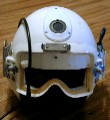

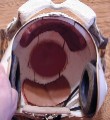

Left: Frontal view of MichaelFox'
DH-101A without visor lens. Note that there are no contact
points for firing an electrical charge. Instead a small pipe is protruding. It is
connected to the
black Teflon tube with the nut and ferrule seen on the left in the picture.
Middle left: Close-up picture of the flash sensor. Middle right: Inside of MichaelFox' helmet. The flash sensor is covered
by the styroliner. Right: Close-up of the labels on the rear.
All pictures © MichaelFox
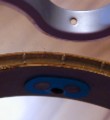


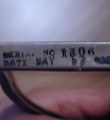
Left: Picture of the visor lens from
below (oblique). Shows that the two
visor lenses are mounted slightly apart.
Middle left: Close-up of the visor lens contact points that would have
matched the male contact point on the visor frame, had they been there
(see the contact points on Milehigh's helmet). Instead this visor lens has
a hole matching the small tube on MichaelFox' visor frame. Middle right and right: Close-ups of numbers and dates on MichaelFox'
visor lens. All pictures © MichaelFox
Message 249, Dec 29, 2003
Hi MichaelFox, Thanks for this affirmation. Do you still have your DH-101A helmet?
If you do, could you check if it has any dates on it? Trey Turner's helmet was dated 1964
and the goggles 1963. It would also be interesting to have a couple of more pictures
including a close-up of the flash sensor.
Cheers, Bluelight
Message 248, Dec 29, 2003
Hi Bluelight, You are correct, the dark disk above the DH-101A visor is the flash sensor
and the electronics and contained in a cutout portion of the Styrofoam liner. The package
is not visible unless you remove the styro liner.
Best regards, MichaelFox
Message 242, Dec 29, 2003
Hi Blaster et al, A quick search in the internet produced the following information from
Trey Turner's old website X-files:
"The DH-101A was manufactured by Omnitech Incorporated and is based on a standard
APH-6 shell.The DH-101A is a Nuclear flash protective helmet assembly. It was used by the
Navy as an experimental nuclear protective helmet. This particular helmet is dated 1964
with the removable glass part of the goggles being dated 1963. It is not know exactly how
the flash protection worked. The glass part of the goggles are double paned glass with a
air space in the middle. They are removable by pushing the silver knobs one each
side."
The bit about double paned glass and the time frame suggests that the goggles operated by
the same system as the developmental electromechanical goggles.
Anyone has more information?
Cheers, Bluelight
Message 233, Dec 29, 2003
Hi Blaster, No, thanks for directing my attention to it. I do not have any information
about it because my sources are USAF heavy. If you do I would be more than happy to
include it.
Cheers, Bluelight
Message 232, Dec 29, 2003
By the by Bluelight, Have you thought about adding the Omnitech DH-101A (picture
attached)?
Blaster
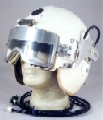
Blaster's DH-101. Note that it has the same type of
black hose and cord
as MichaelFox' helmet. Note also that the upper part of the visor glass
seems to be opaque and that the lower edge of the opaque area seems
to match the contour profile of the lower edge of the visor. © Blaster